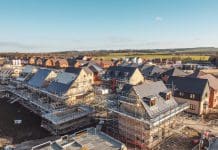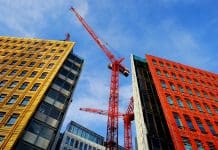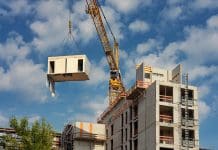May construction PMI data has signalled another slowdown in growth in the sector, particularly a loss of momentum for the residential sector
May construction PMI data has shown the lowest rise in housing activity since the recovery began two years ago.
Higher borrowing costs and intense inflationary pressures were also cited as factors likely to hold back growth over the next 12 months. The latest survey data indicated that business activity expectations at construction companies were the least upbeat since August 2020.
The Managers Index PMI, which measures month-on-month industry changes, registered 56.4 in May, down from 58.2 in April – the lowest reading for four months.
Weaker trends in the house building sub-sector were the main brake on growth, with this index falling to 50.7 from 53.8 in April. Moreover, the latest reading signalled the worst performance for residential work since May 2020.
Commercial building was the fastest growing sector in May
Commercial building was the fastest-growing segment in May, with the speed of expansion easing only slightly since April. Construction companies noted strong demand for commercial work, despite a degree of hesitancy due to the uncertain economic outlook.
Meanwhile, civil engineering activity increased for the fifth month running and at a robust pace, amid a sustained boost from major infrastructure projects.
Total new orders expanded again in May, which marked two years of continuous sales growth in the construction sector. However, the latest increase in new work was the slowest since December 2021.
Construction PMI data showed job creation accelerated in May
Job creation accelerated slightly in May and was the strongest for four months. However, there were widespread reports citing recruitment difficulties due to shortages of suitably skilled candidates.
May construction PMI data highlighted strong demand for construction products and materials, as signalled by a steep and accelerated rise in total purchasing volumes. Efforts to replenish stocks and pre-purchase ahead of price rises also contributed to higher purchasing activity in May, according to survey respondents.
Construction companies suggested that lower consumer confidence, rising borrowing costs and heightened economic uncertainty were all likely to act as headwinds to client demand in the next 12 months.
Residential construction activity was close to stagnation in May
Tim Moore, economics director at S&P Global Market Intelligence, said: “May data signalled a solid overall rise in UK construction output as resilience across the commercial and civil engineering segments helped to offset weakness in house building. Residential construction activity was close to stagnation in May, which represented its worst performance for two years amid signs of softer demand and a headwind from low consumer confidence.
“New order volumes expanded at the slowest pace since the end of 2021, which added to signs that heightened economic uncertainty has started to impact client spending. Concerns about the business outlook were signalled by a fall in construction sector growth projections to the lowest for more than one-and-a-half years in May. Around 19% of construction firms predict an outright decline in business activity during the year ahead, up from just 5% at the start of 2022.
“On a more positive note, supplier delays subsided in May, with the latest downturn in performance the least marked since February 2020. Meanwhile, rapid price pressures persisted due to rising energy, fuel and staff costs, but the overall rate of inflation eased to a three month low in May.”
Industry comment
Mark Robinson, group chief executive at SCAPE commented: “The effects of rising costs and economic uncertainty continues to be felt across the construction industry, with a month-on-month slowdown in the sector’s output painting a concerning picture as we head into the summer months. Construction has long been a bellwether for the wider UK economy so its performance should concern everyone.
‘Conflict in Ukraine continues to place pressure on material prices across the supply chain’
“The ongoing conflict in Ukraine continues to place pressure on material prices across the supply chain and labour shortages remain problematic. Looking ahead, further interest rate rises could start to curb the appetite for private developers in some sectors like residential.
“It’s vital that we sustain the momentum and goodwill built up during recent months as the reality of price increases continues to take centre stage. Ensuring the pipeline of community-led regenerative construction remains strong will require first-class project management and client engagement to encourage the public sector to press on with the delivery of projects during the challenging times ahead.”














